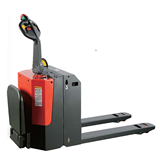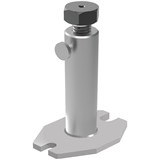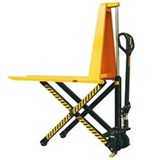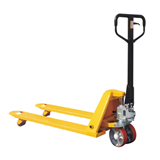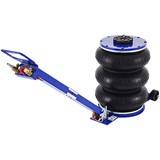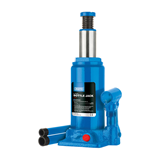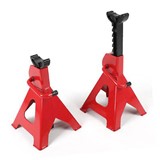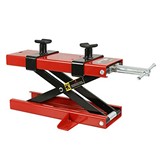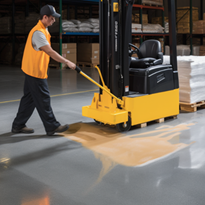Operating a hand pallet jack requires proper technique, attention to safety guidelines, and familiarity with the equipment. Whether you're a new operator or seeking a refresher, understanding the key steps involved in operating a hand pallet jack is crucial for safe and efficient material handling. In this article, we will guide you through the essential steps to operate a hand pallet jack effectively.
Step 1: Pre-Operation Inspection
Before using a hand pallet jack, conduct a pre-operation inspection to ensure it is in proper working condition:
- Check the overall condition of the hand pallet jack, including the wheels, forks, and handle.
- Inspect for any signs of damage or wear, such as cracks, bent forks, or loose components.
- Ensure that the wheels move freely and are not obstructed.
- Test the brakes to verify they are functioning correctly.
- Check the hydraulic system for any leaks or abnormalities.
If any issues are detected during the inspection, report them to a supervisor or the maintenance department and refrain from using the equipment until repairs are made.
Step 2: Load Placement
Properly positioning the load on the pallet is essential for stability and safety. Follow these guidelines:
- Ensure the load is centered on the forks and distributed evenly.
- Position the load against the backstop of the pallet.
- Ensure the load does not exceed the weight capacity of the hand pallet jack.
Step 3: Lifting the Load
To lift the load off the ground using the hand pallet jack:
- Stand behind the handle of the pallet jack and ensure a firm grip on the handle.
- Depress the handle lever to release the hydraulic pressure, allowing the forks to lower to the ground.
- Insert the forks beneath the load, ensuring they are fully inserted and centered.
- Slowly pump the handle lever to raise the forks, lifting the load off the ground. Use a steady and controlled pumping motion to avoid sudden movements.
Step 4: Moving the Load
To move the loaded hand pallet jack to its intended destination:
- Position yourself behind the handle, maintaining a comfortable and stable posture.
- Push the hand pallet jack using your body weight and leg muscles, rather than relying solely on your arms. This provides better control and reduces strain on your upper body.
- Maintain clear visibility of your path and watch for potential obstacles or uneven surfaces.
- Use smooth and controlled movements to navigate corners and turns.
- Avoid sudden stops or changes in direction to prevent load shifts.
Step 5: Unloading the Load
When unloading the load from the hand pallet jack:
- Position the pallet in the desired unloading area.
- Engage the brake to secure the hand pallet jack in place.
- Lower the forks slowly by releasing the hydraulic pressure using the handle lever.
- Ensure the load is fully supported before removing the forks.
Step 6: Post-Operation Maintenance
After completing the task, it is essential to perform post-operation maintenance:
- Clean the hand pallet jack to remove any debris or contaminants.
- Store the hand pallet jack in a designated area, away from traffic and obstruction.
- Report any issues or abnormalities to the maintenance department for timely repairs.
Basic Operating Techniques for a Hand Pallet Jack: Proper Maneuvering and Control
Proper maneuvering and control are essential when operating a hand pallet jack. Mastering the basic techniques ensures safe and efficient material handling. In this article, we will provide detailed instructions on how to properly maneuver a hand pallet jack, including lifting, lowering, steering, and stopping techniques.
Lifting Technique
- Begin with the hand pallet jack positioned behind the load, ensuring the forks are aligned with the pallet.
- Stand in a balanced position, with your feet shoulder-width apart.
- Grip the handle firmly with both hands, keeping your back straight and your knees slightly bent.
- Engage the lifting mechanism by pumping the handle up and down in a controlled manner. This raises the forks and lifts the load off the ground.
- Monitor the load and ensure it remains stable and balanced throughout the lifting process.
- Raise the load to the desired height, taking care not to exceed the recommended maximum height.
Lowering Technique
- Position the hand pallet jack in the desired location for unloading the load.
- Engage the brake mechanism to secure the hand pallet jack in place.
- Ensure there is sufficient clearance above and around the load.
- Gradually release the hydraulic pressure by pushing down on the handle lever in a controlled manner. This lowers the forks and allows the load to gently touch the ground.
- Continue to release the pressure until the forks are completely lowered and the load is fully supported by the ground.
Steering Technique
- Stand in an upright position behind the handle of the hand pallet jack, maintaining a comfortable grip.
- To turn left, push the handle to the left while simultaneously moving forward. Apply gradual and controlled force to avoid sudden movements.
- To turn right, apply the same technique but in the opposite direction. Push the handle to the right while moving forward.
- Maintain awareness of your surroundings and ensure there is sufficient space to make turns safely.
- Take turns slowly and steadily to prevent load shifts or instability.
Stopping Technique
- When approaching a stopping point, release pressure on the handle lever to disengage the hydraulic system.
- Gradually reduce your pushing force while maintaining control of the hand pallet jack.
- Keep your feet firmly planted on the ground for stability.
- Once the hand pallet jack comes to a complete stop, engage the parking brake to secure it in place.
- If necessary, use chocks or blocks to further stabilize the hand pallet jack and prevent unintended movement.
Safety Tips:
- Always maintain clear visibility of your path and watch for obstacles, uneven surfaces, or potential hazards.
- Avoid sudden starts, stops, or changes in direction to prevent load shifts or accidents.
- Use caution when operating on inclines or ramps, ensuring proper control and stability throughout the process.
- Keep a safe distance from other individuals, equipment, or structures to prevent collisions or accidents.
By mastering these basic operating techniques, you can maneuver a hand pallet jack with precision, ensuring safe and efficient material handling in various work environments.
Navigating Challenging Environments: Strategies for Operating a Hand Pallet Jack
Operating a hand pallet jack in challenging environments requires additional skills and strategies to ensure safe and efficient material handling. Whether you're working in tight spaces, navigating ramps, or dealing with inclined surfaces, understanding the following strategies will help you overcome these challenges effectively. In this article, we will discuss strategies for operating a hand pallet jack in challenging environments.
1. Operating in Tight Spaces
When working in tight spaces, it's important to consider the following strategies:
- Assess the space: Before entering a tight space, evaluate the dimensions and clearance to ensure the hand pallet jack and load can fit safely.
- Plan your route: Determine the most efficient path with the least obstacles. Clear any obstructions, if possible, to create a smoother route.
- Maneuver carefully: Use precise steering techniques and make slow, controlled movements. Keep a close eye on the surroundings to avoid collisions with walls, racks, or other equipment.
- Utilize three-point turns: In extremely tight spaces, perform three-point turns by moving forward, turning, and then reversing, ensuring you have enough room to maneuver safely.
By implementing these strategies, you can navigate tight spaces with better control and minimize the risk of accidents or damage to the load or surroundings.
2. Handling Ramps
When faced with ramps, follow these strategies to maintain control and safety:
- Assess the ramp's condition: Check for any defects, slippery surfaces, or debris on the ramp that may affect traction and stability.
- Approach ramps with caution: Reduce your speed and approach ramps straight-on to maintain stability.
- Push, don't pull: When ascending a ramp, position yourself behind the handle and push the hand pallet jack uphill. This utilizes your body weight and leg muscles for better control and stability.
- Descend slowly: When descending a ramp, keep a firm grip on the handle, and control the descent by applying slight backward pressure to prevent the load from accelerating too quickly.
- Maintain clear visibility: Ensure you have a clear line of sight ahead and watch for any potential hazards or obstructions on the ramp.
By employing these strategies, you can navigate ramps safely and maintain control over the hand pallet jack and load.
3. Dealing with Inclined Surfaces
Inclined surfaces require extra caution and control. Consider the following strategies:
- Assess the incline: Determine the degree of the incline and evaluate the surface condition for any potential hazards.
- Position the load correctly: When ascending an incline, position the load with the heavier end at the back to maintain stability.
- Use proper technique: Lean your body slightly forward while maintaining a secure grip on the handle. Push the hand pallet jack using your body weight and leg muscles to counteract the incline.
- Take it slow: Ascend or descend inclined surfaces at a controlled pace to maintain stability and prevent load shifts.
- Monitor the load: Keep a close eye on the load and adjust your technique if you notice any instability or imbalance.
By implementing these strategies, you can safely navigate inclined surfaces and reduce the risk of accidents or load instability.
In conclusion, operating a hand pallet jack requires following essential steps to ensure safe and efficient material handling. These steps include conducting pre-operation inspections, properly placing and lifting the load, maneuvering the hand pallet jack with proper steering and stopping techniques, and performing post-operation maintenance. By mastering these techniques and strategies for navigating challenging environments such as tight spaces, ramps, and inclined surfaces, operators can enhance safety, control, and productivity in their material handling tasks.



